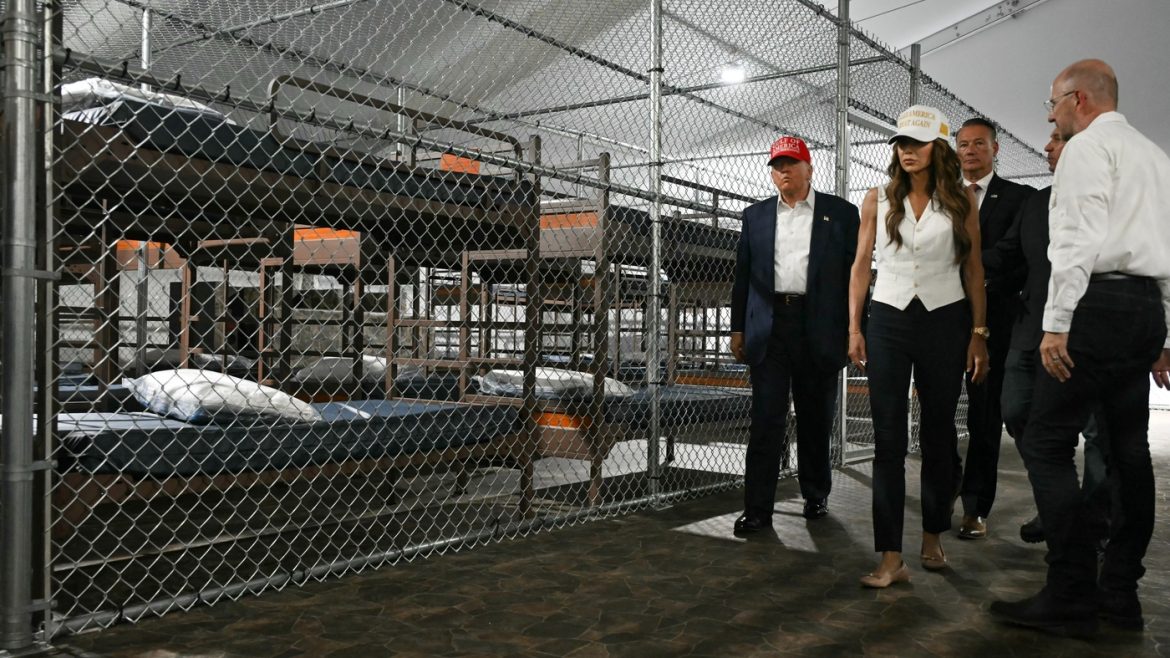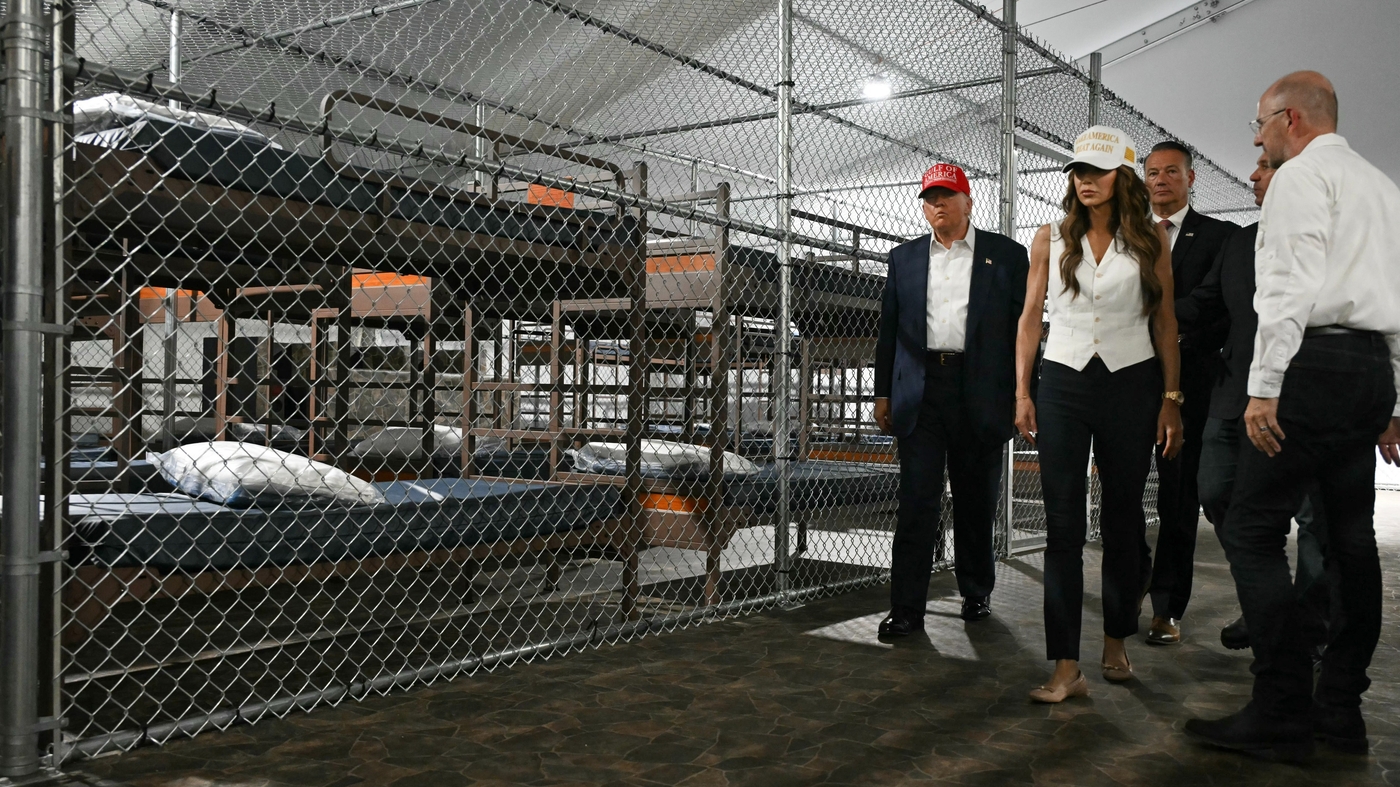The “Shock and Awe” Approach to Immigration Enforcement: A Six-Month Review
Introduction
The return of President Trump to the White House has ushered in a dramatic shift in immigration enforcement, marked by a strategy that has been described as “shock and awe.” This approach, implemented with remarkable speed and intensity, has reshaped federal immigration policy and practices within the first six months of his second term. The goal of this strategy is clear: to create a sense of disruption and deterrence that will fundamentally alter the landscape of immigration in the United States. This report delves into the key aspects of this strategy, its impacts, and the challenges it faces.
The “Shock and Awe” Doctrine: A New Frontier in Immigration Policy
The term “shock and awe” is borrowed from military strategy, where it describes a rapid and overwhelming display of force designed to paralyze the enemy’s ability to respond. In the context of immigration enforcement, the Trump administration has adopted this doctrine to create a sense of disruption and fear that will deter illegal immigration and reshape federal policy.
Key Components of the Strategy
Policy Changes and Their Impacts: A Closer Look
The “shock and awe” strategy has been implemented through several policy changes, each with far-reaching consequences for immigrants and the broader community.
Expanded Enforcement Priorities
One of the first actions taken by the administration was to broaden the scope of enforcement priorities. While previous administrations focused on deporting individuals with serious criminal records, the Trump administration has expanded its targets to include anyone in the country illegally. This has led to the arrest and deportation of individuals with minor offenses or no criminal record at all, creating a sense of uncertainty and fear within immigrant communities.
Restrictions on Asylum
The administration has also implemented policies designed to restrict access to asylum. These include measures that make it more difficult for asylum seekers to enter the country, such as the Migrant Protection Protocols (MPP), which require asylum seekers to remain in Mexico while their cases are processed. These policies have been criticized by human rights organizations for exposing vulnerable individuals to dangerous conditions and limiting their access to legal protections.
Increased Border Security
Another key component of the “shock and awe” strategy is increased border security. The administration has continued to push for the construction of a wall along the U.S.-Mexico border, and has deployed additional personnel and technology to deter illegal crossings. These measures have been accompanied by increased enforcement actions against individuals who attempt to enter the country illegally, leading to a surge in arrests and detentions.
Funding and Resources: Fueling the Enforcement Machine
The “shock and awe” strategy has been accompanied by a significant increase in funding for immigration enforcement agencies. Congress has approved tens of billions of dollars in additional funding, making it the largest domestic enforcement funding in U.S. history. This funding has been used to hire additional Immigration and Customs Enforcement (ICE) agents, expand detention facilities, and acquire new technologies for border surveillance.
Impacts of Increased Funding
Legal Challenges and Resistance: Pushing Back Against the Strategy
The Trump administration’s immigration policies have faced numerous legal challenges, with dozens of judges across the country ruling against them. These challenges have focused on issues such as due process, asylum rights, and the separation of powers.
Court Rulings
Several courts have blocked the administration’s attempts to restrict asylum access, ruling that they violate U.S. and international law. Other courts have challenged the administration’s efforts to expand deportation grounds, arguing that they exceed the authority granted by Congress. These legal challenges have created a patchwork of rulings that have limited the administration’s ability to implement its policies.
Resistance from States and Localities
In addition to legal challenges, the administration’s policies have faced resistance from states and localities. Some states have passed laws to protect immigrant communities and limit cooperation with federal immigration enforcement efforts. This resistance has created a complex landscape for immigration enforcement, with some jurisdictions actively working to undermine the administration’s policies.
The Human Cost: A Price Too High?
While the “shock and awe” strategy may achieve some of its intended goals, it comes at a significant human cost. The increased enforcement actions and restrictive policies have created fear and anxiety within immigrant communities, separating families and disrupting lives.
Separation of Families
One of the most controversial aspects of the administration’s policies has been the separation of families at the border. Under the “zero tolerance” policy, parents who crossed the border illegally were prosecuted, leading to the separation of children from their parents. This policy has been widely condemned by human rights organizations and child welfare advocates, who argue that it causes lasting trauma and harm to children.
Impact on Communities
The increased enforcement actions have also had a chilling effect on immigrant communities, making it more difficult for immigrants to access essential services such as healthcare and education. Many immigrants are afraid to report crimes or seek medical care for fear of being deported. This has created a climate of fear and mistrust that has undermined the ability of immigrant communities to thrive and contribute to the broader society.
The Future of Immigration Enforcement: Uncertainty and Possibility
The future of immigration enforcement under the Trump administration remains uncertain. While the administration has achieved some successes in implementing its “shock and awe” strategy, it faces significant legal and political challenges.
Potential Scenarios
Conclusion: A Legacy of Disruption
Six months into President Trump’s second term, the “shock and awe” immigration enforcement strategy has undeniably left a mark. While proponents tout its effectiveness in deterring illegal immigration, critics highlight the human cost and legal challenges. This period has been characterized by disruption, uncertainty, and a reshaping of the landscape of immigration policy, the long-term effects of which remain to be seen. As the administration continues to pursue its agenda, it will be crucial to monitor the impacts of these policies on immigrant communities and the broader society. The legacy of this strategy will be shaped by the balance between enforcement and compassion, and the ability of the administration to navigate the complex legal and political landscape.


